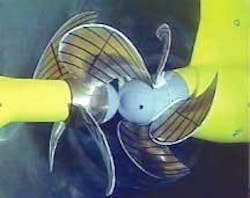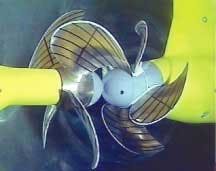CRP propulsion may have bright future for LNG carriers
Jennifer Pallanich Hull
Special Reports Editor
With a commercial order for its contra-rotating propeller (CRP) Azipod pro-pulsion systems, ABB believes the concept has a great future in the off-shore industry with LNG carriers. Mitsubishi Heavy Industries has ordered two CRP Azipod systems for a pair of ropax ferries that will operate inside Japan. In the CRP Azipod concept, ABB placed a steerable Azipod unit immediately behind the standard propeller in a design allowing the pod-pulling propeller to contra-rotate in relation to the shaft-driven main propeller.
The propellers are located on the same axis without any physical connection. The CRP design, introduced in 2001, gives about a 10% boost to hydrodynamic propulsion efficiency, ABB said. The efficiency improvement comes from the aft propeller utilizing the energy from the forward propeller's rotation and the single skeg hull design, the company said.
The CRP "power rudder" is the "same idea but a new way of thinking," said Sakari Sorsimo, ABB sales manager.
The company said the CRP Azipod design offers the best hydrodynamic propulsion efficiency.
The load ratio for the propellers is split, with the main propeller carrying a 60% to 70% load and the Azipod propeller bearing the rest. ABB said it designed the Azipod propeller diameter to be smaller than the main propeller to prevent main propeller tip vortex cavitation from hitting the Azipod propeller in autopilot steering angles. The two propellers have different numbers of blades to avoid blade resonance.
The unit's control system allows the propulsion system to work with slow and medium speed engines, electric drives, and fixed-pitch and controllable pitch propellers. It can be used with dynamical positioning, autopilot, and speedpilot systems. ABB sees the CRP system as being useful for shuttle, product, and chemical tankers in addition to container and ropax vessels.
"The LNG market is worth looking into," he said.
null
The CRP system offers operational, technical, and economical improvements, ABB said. Operationally, users will see better vessel operation at lower speeds and improved safety levels in crashstop, emergency maneuvering, and heavy weather situations. Technically, the system removes the need for stern thrusters or rudders, provides redundancy with two independent propulsion systems, and makes possible a flexible general arrangement. Economically, system efficiency improves fuel economy, maneuvering capability reduces the need for tug boats, and time savings in the harbor and coast areas translate to fuel savings. Hydrodynamic efficiency is increased because the after propeller recovers the rotational velocity component left behind by the main propeller, ABB said. The company believes the CRP concept is probably the only way to considerably improve the propulsive efficiency.
Model testing for the concept studies were carried out in 2000 at Marintek in Norway and in 2001 at the Samsung Model Test Basin. The model tests showed the CRP Azipod had better hydrodynamic efficiency than regular pod propulsion, single screw-single skeg, twin screw-twin skeg, and twin screw-single skeg, the company said.
Compact Azipod
ABB expects to deliver eight Compact Azipod units in July for GlobalSantaFe's Rig 184 and eight units for Rig 185 in 2004. For each rig, being built by PPL Shipyard in Singapore, ABB will deliver eight 3.2 MW Compact Azipods with variable speed drives, eight 3.6 MW generators, two 11 kV high-voltage switchboards and transformers, low voltage switchboards, AC variable speed drives for drilling system and anchor winches, and system engineering and network study.
ABB is also slated to deliver two Compact Azipod units for Island Offshore's Normand NN support vessel in 2003 and two for the US Coast Guard for an icebreaker in 2005. ABB, which delivered its first Compact Azipod units in 2001 for Island Offshore's Normand Rover support vessel, said it has received orders for 35 Compact Azipod units in all.
null
The unit is constructed with standardized modules for speedy installation.
Located underwater, the Compact Azipod system has low noise and vibration compared to conventional electric drive systems, and the space otherwise taken up by the propulsion motors is freed for other uses.
"Some of the people are complaining, 'It's too quiet. It doesn't sound like a ship anymore,'" Sorsimo said.
The system is dismountable underwater.
There are three main modules: a steering module and a mounting block, a housing module, and a motor module and propeller.
The Azipod system is an azimuthing electric propulsion drive in which the propulsion motor is installed inside a submerged azimuthing pod and coupled directly to an extremely short propeller shaft. The variable speed electric drive produces smooth torque over the entire speed range including zero speed. Azipod units are available in up to 25 MW powers and up to 4.3 MW with the Compact Azipod.
Azipod offers benefits in dynamic performance and maneuvering characteristics, hydrodynamic efficiency resulting in shorter harbor times, reduced fuel consumption, safer operation in harsh weather, restricted passages, and offshore environments.
ABB said using the electric propulsion system results in several benefits, including higher safety and redundancy levels and more space because of higher layout flexibility. ABB said the system also offers environmental benefits in terms of lowered exhaust emmissions from improved fuel efficiency, lower maintenance requirements, improved safety, and decreased plume impact on the seabed.


